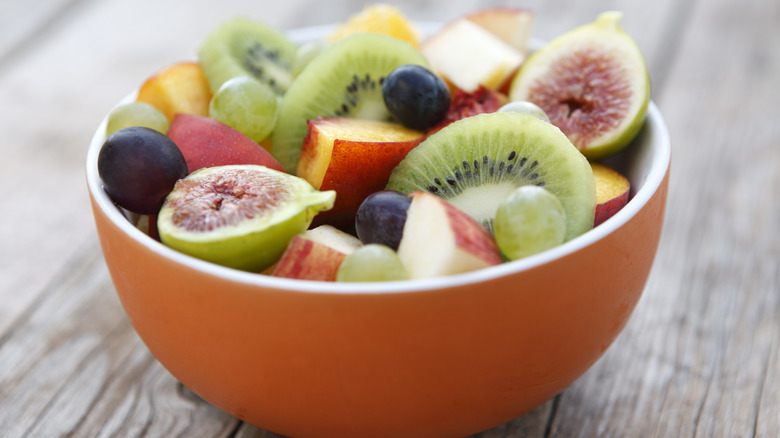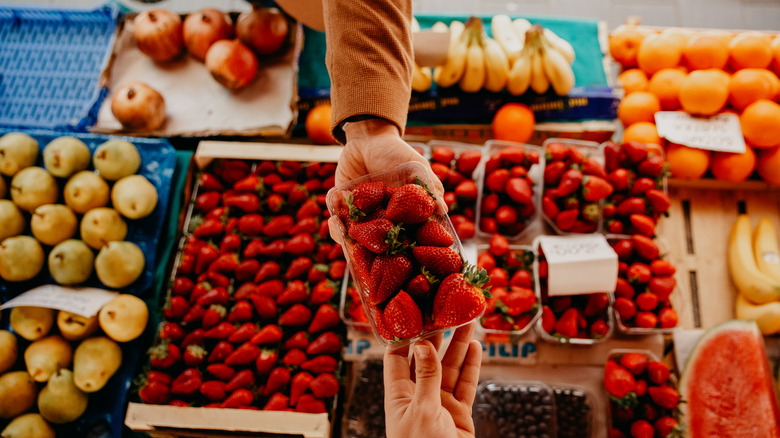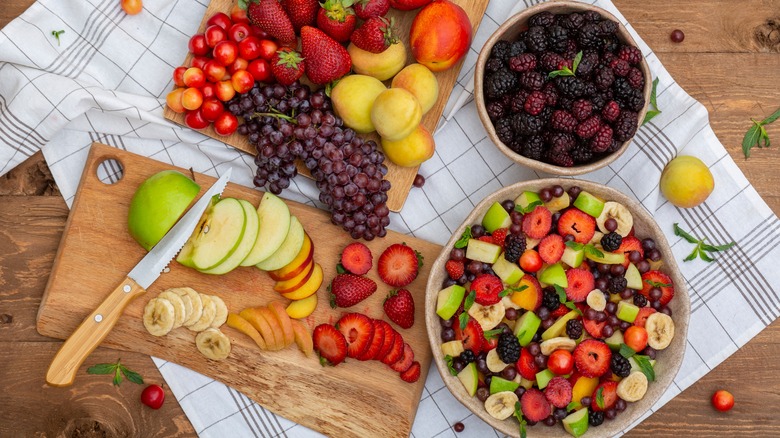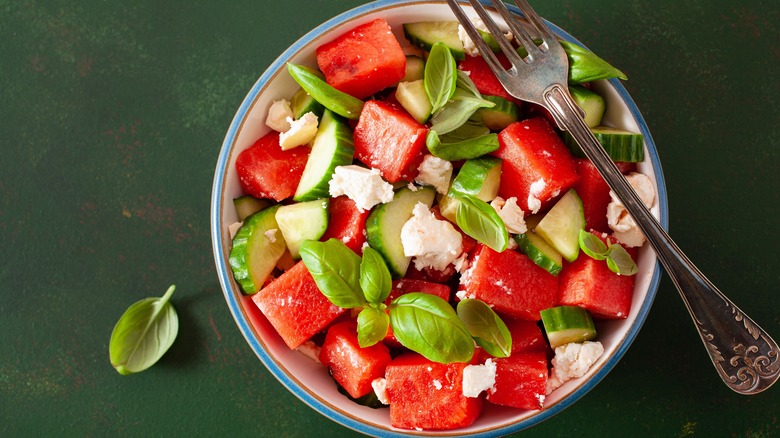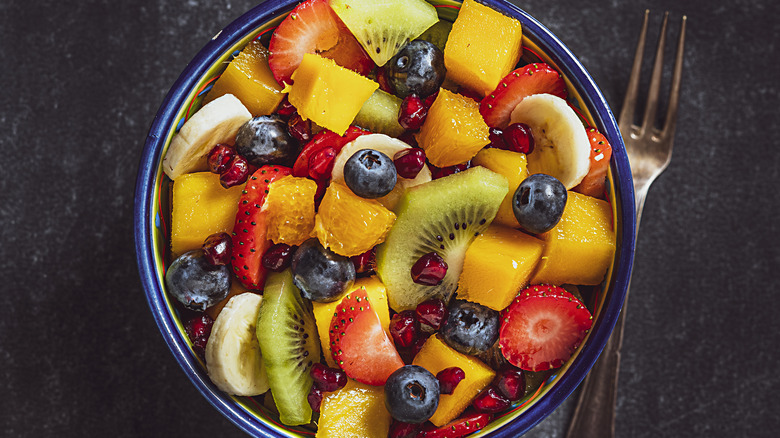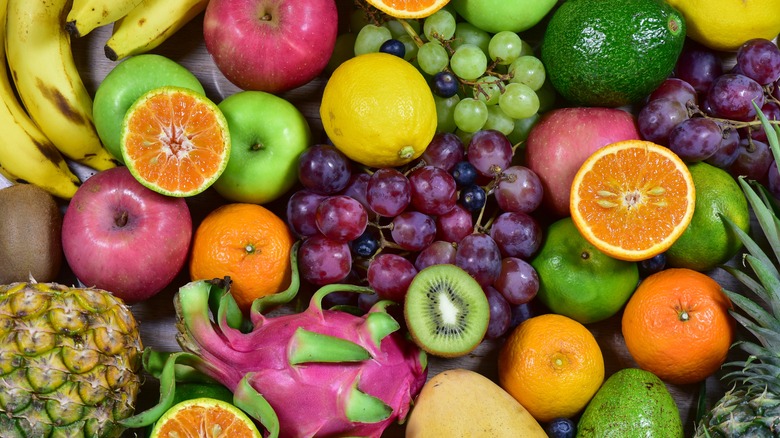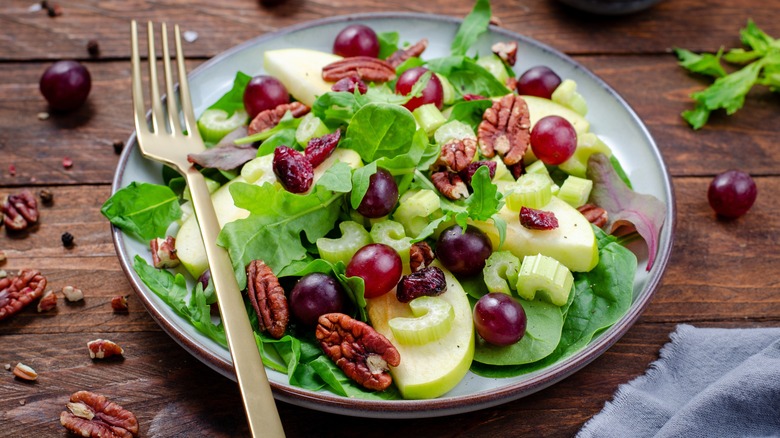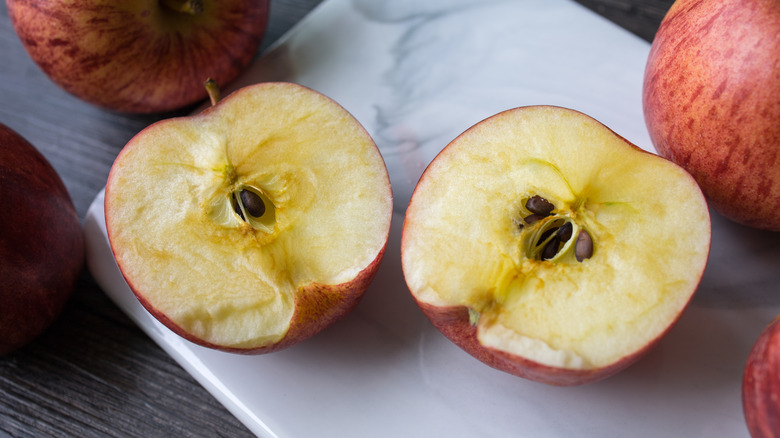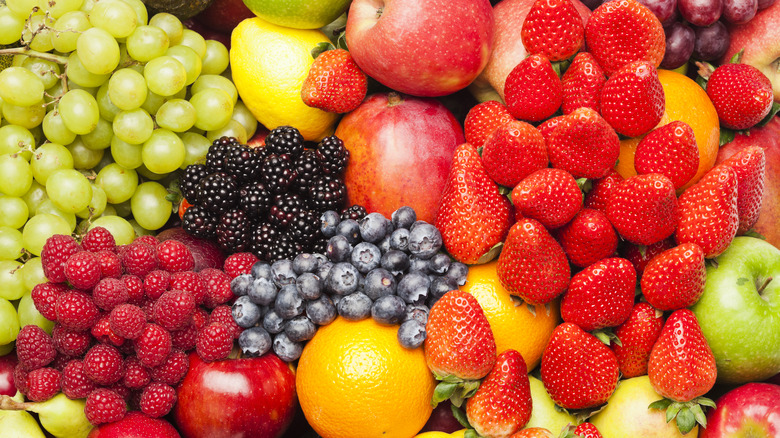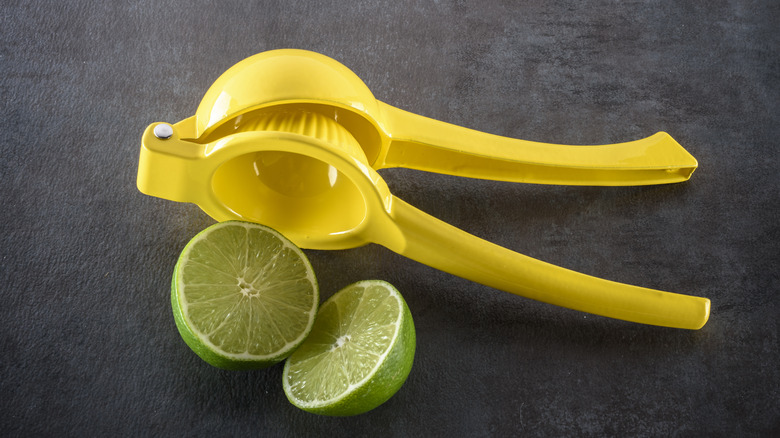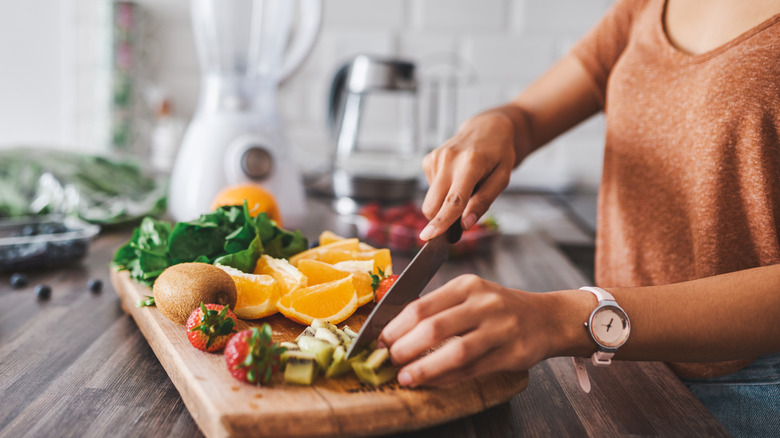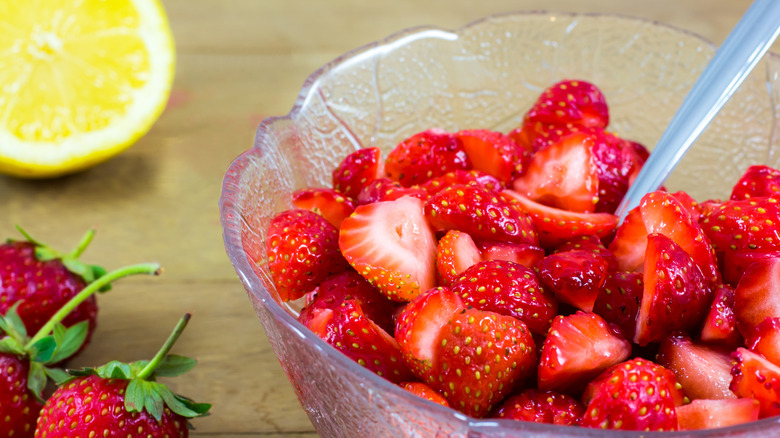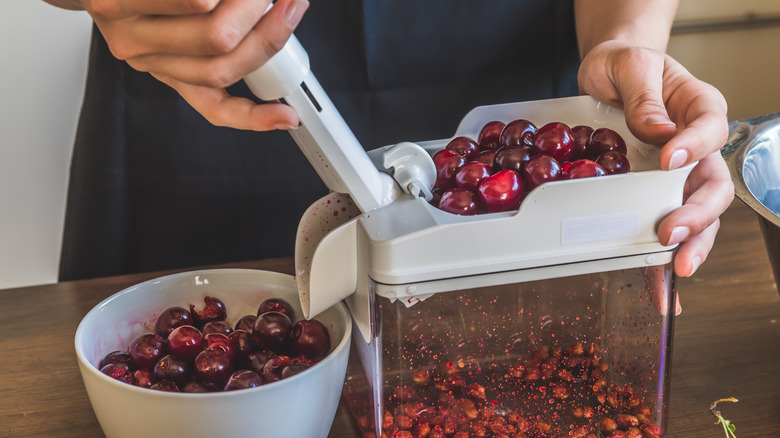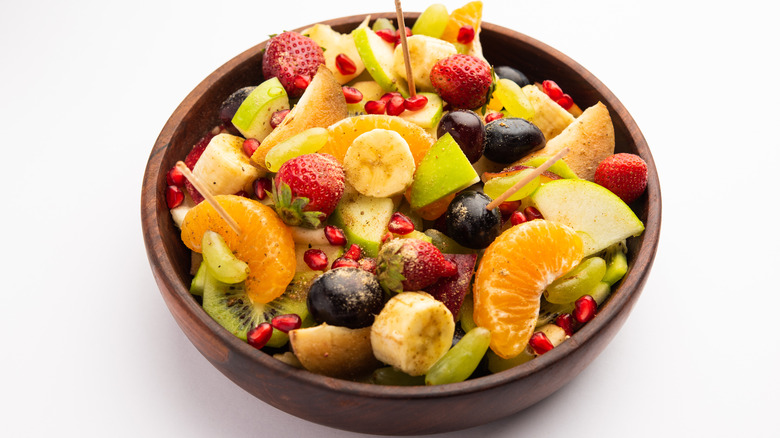Mistakes Everyone Makes With Fruit Salad
Fruit salad is often seen as a boring dish. It's the thing that's always leftover on a potluck table or is seen as a lesser alternative to a "real" dessert. But it doesn't have to be that way. If you're sick of lackluster bowls filled with random chunks of fruit, you might just be falling afoul of the common mistakes everyone makes with fruit salad.
Whether you're looking to master the skills of a good fruit salad or you're wondering why you're always encountering bad versions on menus or at group gatherings, it's important to learn about these pitfalls. You can go wrong with fruit salad in all kinds of ways, from using fruit that's out of season to ignoring texture and dressings that can liven up the dish. There are some obvious mistakes, like using unripe fruit or leaving pits and stalks behind. But you can also trip up on less obvious mistakes, such as playing too safe with your ingredient choices or not looking beyond fruit.
If this is starting to sound overwhelming and like it's way too much thought to put into fruit salad, don't worry. Making a great one is much easier than you might think. We're going to go over some of the top mistakes people make with fruit salad and explain how to solve or avoid these errors. Once you're in the know, it's simple to make a memorable fruit salad so that you won't be hauling home leftovers after the picnic.
Not using seasonal fruit
The best fruit salads are made using seasonal fruit. If you're using out-of-season fruit flown halfway across the globe to a supermarket shelf, you're making a mistake. But why is this important? Well, the main reason is flavor. There's nothing quite like those perfect spring strawberries or summer peaches and plums, ripened by the sun. The other great thing about seasonal fruit is that it tends to be cheaper. Since it doesn't need to be flown long distances or grown in hot houses, the production costs are lower and it can be sold for less.
So, try to use predominantly seasonal fruit in your fruit salad and notice the difference. Not sure what to use? Strawberries are one of the best fruits available in spring. Then as late spring arrives, you'll find some excellent cherries and apricots. Summer is a particularly great month for fruit. In-season fruits include plums, peaches, most types of melon, blackberries, raspberries, figs, and nectarines. In fall, pears and apples are at their best, as are persimmons and grapes. Winter is a great time for citrus and kiwi fruits. There are times when you might need to supplement seasonal offerings with some out-of-season fruit, but sticking to mostly seasonal fruit makes a big difference.
Using fruit you don't like just because you think it should be in a fruit salad
Some people have strict rules about what does and doesn't belong in a fruit salad. There are folks who love the crunch of apple slices in the mix and others who find apples a boring addition. Others adore bananas in fruit salad, while their counterparts think it's the work of the devil. Honestly, you're never going to get everyone to agree on what belongs in fruit salad. So your best bet is to use fruit that you actually like.
There's no reason to add a fruit you hate (or hate in fruit salad) just because other people see it as a must-have. By ignoring the unofficial rules of fruit salad, you might come up with some more interesting combinations than someone who's following the conventional fruit salad playbook. That said, if you're making it for a group of people and you know they all hate grapes in fruit salad, for instance, then maybe you should leave it out this time, even if you like it. So cater to your preferences but also consider what the people you're making it for will like.
Not thinking about colors
You've probably heard people say that we eat with our eyes first. Pretty gross if taken literally, but there's definitely truth to it in a metaphorical way. The ways that food looks and how it's presented can make a big difference to how tasty our brains assume it's going to be. Now, you can't completely get away with making a subpar fruit salad just because it's beautiful, but it'll be even better if it looks like something you want to eat, like, right now.
Thinking about color is important. Fruit has the benefit of coming in all kinds of gorgeous hues, from the rich orange-yellow of mango to the blues and purples of grapes and blueberries to the vivid red of strawberries. There's a whole rainbow of colors to explore there. Now, what looks good is subjective. For some people, that's going to mean hitting up every color of the rainbow. Others might prefer a more limited color palette — think bright red strawberries and watermelon contrasted with the green of kiwi fruit and fresh basil leaves. Whatever your color preference, it's something you should consider before choosing the fruits for your salad.
Choosing fruits with identical textures
You don't want to bite into a fruit salad where everything's just soft. Perfectly ripe mangos, peaches, and plums might taste great together, but their soft, bordering on mushy, texture is going to make it feel like you're choking down mouthfuls of baby food. On the other end of the spectrum, there's not much enjoyment to be had from a fruit salad where everything's crisp or hard. That's why it's important to consider texture when picking the fruits for your salad.
It's good to have a mixture of soft and crisp fruits in your fruit salad. You might want to pair soft, perfectly ripe figs with crisp cubes of watermelon or tender, juicy nectarines with crunchy slices of apples or firm, whole grapes. These contrasting textures make a fruit salad more interesting to eat. Rather than feeling like the dish is one-note, you'll be delighted by the interplay of textures. It's not something that everyone thinks about, but it can make or break a fruit salad. Chefs often talk about texture in cooking and this is why. Well-balanced textures create a sensory experience that humans enjoy, and they can play almost as big a part in great food as the flavors.
Using too many types of fruit
You're making fruit salad so it might seem like you should add as many types of fruit as possible. But, if this is your initial instinct, you're falling for a common mistake: using too many types of fruit. The trouble when you use too many different fruit varieties is that you start to lose the individual fruit flavors and the interplay between a few great flavors. You end up with just a generic fruit flavor.
Think about what happens when you make a smoothie with too many fruit varieties or a soup with a random assortment of vegetables left in your crisper drawer. What you end up with can taste muddy and lackluster. It lacks the nuances of a well-selected combination of fruits or veggies. The same goes for fruit salad. A fruit salad with too many types of fruit lacks finesse. Not to mention that some fruits just don't go together all that well.
What you should do instead is think about the fruit varieties you decide to use and what they taste like together. If they'd taste good together in a smoothie, then they'll probably make a good fruit salad, too. You can't go wrong with a berry fruit salad, featuring strawberries, raspberries, blueberries, and blackberries — especially when they're in season. You might want to combine tropical fruits, such as pineapple, mango, and passionfruit. Peaches and raspberries taste amazing together, especially when brightened with fresh mint.
Not looking beyond fruit
Just putting fruit in your fruit salad? We hate to break it to you, but that's boring. Fruit salad can contain more than just fruit and, honestly, it should. So what should you be adding other than fruit? First, nuts make a great addition to fruit salad. They add both texture and flavor, so they're great for mixing into fruit salads made using mostly soft fruits to avoid a one-note texture.
Cheese is another possible addition to fruit salad. But you have to be careful here. You can't just add slices of American cheese or lumps of cheddar to a mixed fruit salad, there needs to be some cohesion. For instance, you might crumble some feta over a strawberry fruit salad or add blue cheese to pear and quince salad.
Herbs make a great addition to certain fruit salads. Mint is an obvious choice, as it's often associated with sweet dishes, but you could get away with some less conventional herbs, such as dill or cilantro with some fruit combinations. For instance, mango, pineapple, lime, and cilantro would be a nicely balanced dish. You can also include some greens and veggies in fruit salad, such as arugula, fennel, or cucumber.
By looking beyond fruit, into the realm of herbs, nuts, vegetables, and other additions, you can end up with some sophisticated combinations. These are fruit salads that wouldn't be out of place at a fancy dinner party.
Letting your fruit brown
If you make fruit salad ahead of time, one of the potential issues is that your fruit will brown. This doesn't mean your fruit has gone bad, but it doesn't look its best. The reasoning for browning is oxidation. When oxygen meets the surface of certain fruits — such as apples and pears — a chemical reaction takes place, causing browning to occur.
But, luckily, there are ways to keep fruit from browning. Some people suggest mixing lemon juice into your fruit salad. While this might work, it also gives your fruit salad a distinctly lemony flavor, which you might not want. Instead, you can try making a solution of lemon and water and soaking your fruit (only the fruits prone to browning) in it. This helps prevent browning without imparting too much flavor. Citric acid is even more effective at preventing browning, either sprinkled on fruit or made into a solution with water in which you can soak your fruit. However, it's harder to get hold of, so it's not always the most practical method.
Choosing fruit at varying degrees of ripeness
A common misstep many folks make with fruit salad is choosing fruits at varying stages of ripening. You might combine some perfectly ripe plums with a nectarine that's still hard enough to produce a crunch. This can throw off the balance of a dish. Fruit that's underripe just isn't at its best. Not only is the texture all wrong but it doesn't taste as sweet as it should, meaning your fruit salad has room for improvement.
You should always make sure the fruit you choose is ripe. Be careful that it isn't overripe. Fruit that's too ripe can have brown spots, a mushy texture, and sometimes tastes unpleasant or slightly fermented. It can be hard to make sure all the fruit you buy is equally ripe, but ideally you can find ripe fruit on the day you want to make your salad. If not, store fruit that's already ripe in the fridge but leave fruit that's still slightly underripe on the counter so that it will reach its perfect ripeness. You may be able to hasten the process by storing it near an apple or a banana.
Ignoring dressings
Never thought to dress your fruit salad? Then you're missing out on a step that could elevate the dish to the next level. Yes, fruit is delicious all on its own, but there are plenty of things that taste good that we choose to further improve with the use of sauces or dressings. And fruit salad shouldn't be an exception to this.
If you're not sure where to begin with fruit salad dressing, start simple. A balance of sweet and tart is great with fruit. So you might want to start with lime juice and honey, or grapefruit juice and agave nectar. The sweet, syrupy element adds a bit of thickness to the dressing and balances out the tartness of the citrus.
You could also add herbs and spices to a dressing for fruit salad. For instance, you could blend some fresh mint with citrus juice or berries to create a kind of sweet pesto to drizzle over your fruit salad. Cinnamon works well in dressing for autumnal fruit salads with ingredients such as apple and pear. And ginger is a zingy addition to dressings when you want to add brightness. It's a little bit like making a salad dressing, but you'll want to choose flavors that will work well with sweet fruits rather than savory salad ingredients.
Using unequal quantities of ingredients
While you don't need to use the exact same amount of each ingredient measured to the ounce, you should make the amounts fairly even. The problem with fruit salads that contain a lot of one ingredient and not much of another is that when it's dished up, the bowls won't be balanced. Few people want a fruit salad that's mostly apple slices with just a few chunks of mango and a couple of grapes.
The other factor is that some people cherry-pick their favorite fruits from a bowl of fruit salad. We're not condoning this kind of behavior, but it happens. So if you have a lot of the more everyday fruits and a smaller quantity of the most interesting fruits, before long, people are going to pick out all the good stuff and you'll be left with a "fruit salad" that's actually just cantaloupe or slices of pear. To avoid this, try to keep things even when you're making fruit salad.
Not considering macerating your fruit
Although you don't have to macerate fruit for a fruit salad, it's a good idea to at least consider it. But what exactly does it mean to macerate fruit? Well, it's a simple process that involves soaking fruit in a liquid to soften it and enhance its flavor.
The choice of liquid depends on your desired flavor profile. Common options include sugar syrup (made by dissolving sugar in water), fruit juice (such as orange juice or lemon juice), liqueurs (such as Grand Marnier or rum), vinegar, or a mixture of ingredients. For instance, you could mix balsamic vinegar with agave nectar for sweetness and citrus zest for tartness. Other ingredients you can add to a macerating liquid include vanilla extract, fresh herbs, spices, and grated ginger.
When you've sorted out the liquid, you simply pour it over the fruits, mix to combine, cover the bowl, and refrigerate it for up to 48 hours. If you're macerating crunchy fruits or fruits with skins, such as grapes or blueberries, they'll need longer than chunks or slices of soft fruit. So you can give some fruits a head start before adding the softer varieties. Maceration is a great option for bland blueberries or other fruits that aren't quite up to par. If you have fruits that are underripe or just a bit tasteless, macerating them is a perfect solution.
Leaving stems and pits behind
It goes without saying, but you don't want any stems or pits left in your fruit salad. At best, this could lead to an unpleasant mouthful of food. At worst, someone could break a tooth or even choke on a large fruit pit. It's a good idea to start by removing all the stems before you start chopping. By doing so, you know that you won't accidentally leave one behind while you're chopping.
With this out of the way, it's time to pit stone fruits. Some fruits are easier than others. With larger fruits, such as peaches and plums, you just have to halve the fruit with a knife and gently pull or twist the halves away from the pit. Pitting cherries is the most time-consuming part and the step where you're most likely to leave a pit behind. If you'll be pitting a large number of cherries, you might want to invest in a cherry pitter.
Playing it safe
If there's one thing to take away here, it's don't play it safe with your fruit salad. Can a basic fruit salad be nice enough? Yes. But can it be great or memorable? No. The only way to make a truly good fruit salad is to go for the unexpected. So if you love being creative in the kitchen, let your imagination run wild and play with flavor combinations. If you're more of a rigid recipe follower, you might need a bit of inspiration.
You can try pairing grilled fruit, such as peaches, pineapple, or banana, with some more conventional raw fruit offerings. Cooking fruit caramelizes it and intensifies the flavor, making it a real treat in a fruit salad. There's also the option to add fruits that are usually used in more savory applications, such as tomatillos or avocados.
Seasoning your fruit salad is another way to kick things up a gear. A sprinkle of salt in your fruit salad can intensify fruit flavors and balance the sweetness. You can also try some spicy seasonings, such as ancho chile powder, Tajín, or chaat masala — an Indian spice blend often used on fruit. Blending up fresh herbs with ginger and lime juice makes a zippy dressing for a fruit salad, and adding grains or veggies can be an interesting twist. Basically, have fun with it, and don't make it boring.
